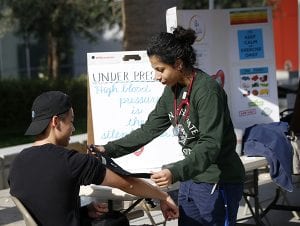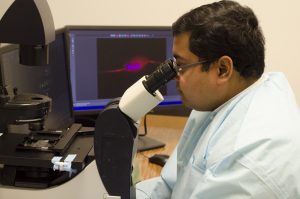- A nursing student takes a peer’s blood pressure during the College of Health and Human Sciences Health and Wellness Week Tuesday, Oct. 23, 2018, in San Jose, Calif. ( Josie Lepe/San Jose State University )
- Community partners offer tips on scooter and bicycle safety during Health and Wellness week Oct. 23. ( Josie Lepe/San Jose State University )
- Students interact with a canine companion during an event on Tuesday, Oct. 23, 2018, in San Jose, Calif. ( Josie Lepe/San Jose State University )
The College of Health and Human Sciences (CHHS) hosted a week-long celebration of health and wellness in October to highlight San Jose State University’s commitment to creating a culture of wellness through its community connections. The second annual Health and Wellness Week was held Oct. 22-26, with booths set up daily to help students and community members learn about hygiene during flu season; handling stress; and managing heart health as well as special events throughout the week such as an SJSU Fitness Challenge, a workshop on bike and scooter safety, and cooking demonstrations.
The week of events aligns with both the mission of CHHS to intentionally promote health, global awareness, social justice and innovation as well as the university’s participation in the Centers for Disease Control’s Healthy Campus 2020 initiative.
“The opportunity to leverage this initiative with a celebration of health-based community partnerships that focuses both on internal as well as external wellness initiatives is exciting,” said Mary Schutten, dean of the College of Health and Human Sciences, “And this is really what the college is seeking to do, positively impact the health and wellness of our communities. It was a great week of collaboration and fun.



